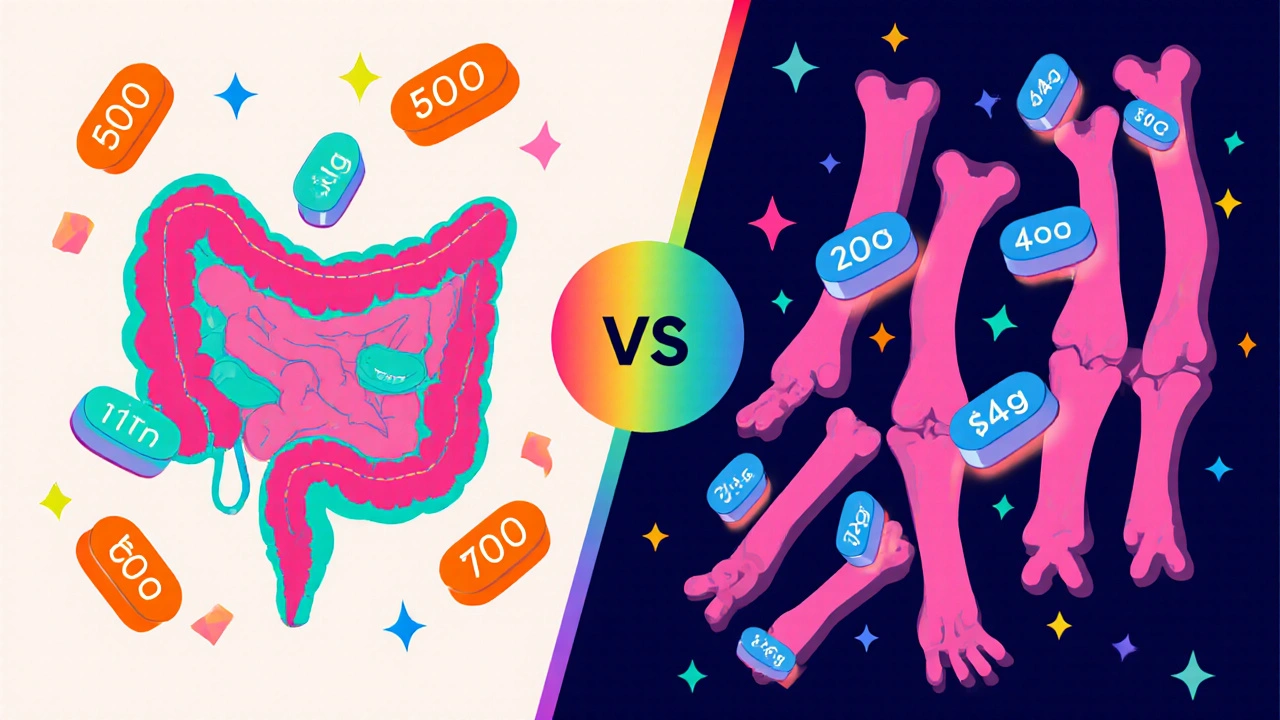21 Oct 2025
- 9 Comments
Sulfasalazine Dose Calculator
Dosage Calculator
Calculate your appropriate sulfasalazine dose based on your condition and patient factors.
Results
Your recommended dosing information
Enter your information above to see your recommended dose.
Titration Schedule
Start low and increase gradually every 1-2 weeks until reaching target dose.
Monitoring
Regular blood tests (CBC, LFTs, renal panel) are essential during dose adjustment.
Key Takeaways
- Start low, go slow: most adults begin with 500 mg once or twice daily and titrate up.
- Ulcerative colitis typically needs 2-4 g per day; rheumatoid arthritis often settles around 1-3 g.
- Kidney and liver function, pregnancy, and age all shift the optimal dose.
- Regular blood tests (CBC, LFTs, renal panel) catch dose‑related side effects early.
- Never change your dose without a doctor’s order - even a small adjustment can alter effectiveness.
What is Sulfasalazine is a combination of sulfapyridine and 5‑aminosalicylic acid (5‑ASA) used to treat inflammatory bowel disease and rheumatoid arthritis?
Sulfasalazine belongs to the sulfa drug family. After you swallow the tablet, gut bacteria split it into two active parts: sulfapyridine, which mainly tackles the immune response, and 5‑ASA, which calms inflammation in the colon. Because the drug works in two places, doctors can prescribe it for two very different conditions - ulcerative colitis (UC) and rheumatoid arthritis (RA). The molecule was first approved in the 1950s, and more than 30 million prescriptions have been written worldwide.
Why the right dose matters
Too low a dose won’t control inflammation, leaving patients with painful flares, joint swelling, or bloody stools. Too high a dose raises the risk of nausea, headache, photosensitivity, and rare blood‑cell problems. The sweet spot varies because the body’s ability to process sulfasalazine changes with age, organ health, and other meds.

Standard dosage guidelines
Guidelines from the American College of Gastroenterology (2023) and the American College of Rheumatology (2024) serve as the starting point. Below is a quick snapshot.
| Condition | Initial dose | Target maintenance dose | Typical titration period |
|---|---|---|---|
| Ulcerative colitis | 500 mg once daily | 2 g - 4 g per day (split BID) | 2-4 weeks |
| Rheumatoid arthritis | 500 mg once daily | 1 g - 3 g per day (split BID) | 3-6 weeks |
The key idea is a “loading” phase - a low start that lets your gut bacteria begin the split - followed by gradual increases every 1-2 weeks until the target range is reached.
How doctors fine‑tune the dose
After you hit the target dose, doctors watch three main signals:
- Clinical response: Are flare‑ups fewer? Is joint pain improving?
- Laboratory markers: C‑reactive protein (CRP) for inflammation, complete blood count (CBC) for anemia, and liver enzymes (ALT/AST) for hepatic stress.
- Side‑effect profile: Nausea, rash, or photosensitivity often appear before blood work shows a problem.
If labs drift high or symptoms persist, the physician may:
- Reduce the dose by 250-500 mg steps.
- Switch to an alternate 5‑ASA (e.g., mesalamine) if colon‑specific inflammation isn’t responding.
- Add a disease‑modifying drug like methotrexate for RA when sulfasalazine alone is insufficient.
Special populations
One‑size‑fits‑all doesn’t work for children, pregnant people, or those with organ impairment.
Pediatric dosing
For kids 2 - 17 years, the usual regimen is 30-40 mg/kg per day, split into two doses. The maximum daily dose caps at 2 g to avoid excess sulfapyridine exposure.
Pregnancy and lactation
Data from the European Medicines Agency (2022) suggest sulfasalazine is relatively safe in the second and third trimesters, but it crosses the placenta. Doctors typically keep the dose at the lowest effective level and monitor fetal growth with ultrasounds.
Elderly & organ function
Kidney clearance drops about 1 % per year after age 40. For patients with a creatinine clearance < 30 mL/min, the dose should be reduced by 25 % and lab checks increased to every 2 weeks. Liver disease also warrants a 25 % cut because sulfapyridine is metabolized hepatically.
Side effects linked to dose
Most side effects are dose‑dependent:
- Gastro‑intestinal upset - nausea, loss of appetite, more common above 3 g/day.
- Blood‑cell changes - leukopenia or thrombocytopenia usually appear when serum sulfapyridine > 20 µg/mL.
- Skin reactions - rash and photosensitivity increase with higher systemic exposure.
- Renal stones - rare, but higher doses raise urinary sulfonamide concentrations.
If any of these arise, the first step is to pause the medication and re‑check labs before deciding on a dose reduction or switch.
Practical tips for patients
- Take the tablet with food to improve absorption and reduce stomach upset.
- Never split a tablet unless your pharmacist provides scored halves.
- Carry a photo‑ID card stating you’re on sulfasalazine - useful for sunscreen or allergy alerts.
- Set a calendar reminder for blood‑test appointments (baseline, 2 weeks, then monthly during titration).
- Report any new rash, fever, or unusual bruising right away.
Remember, the goal isn’t just to hit a number on the bottle; it’s to keep inflammation under control while staying comfortable.
Frequently Asked Questions
How long does it take to feel the effects of sulfasalazine?
Most patients notice improvement after 2-4 weeks of reaching a therapeutic dose. Full remission in ulcerative colitis can take 8-12 weeks.
Can I take sulfasalazine with other meds?
Yes, but watch for interactions. Methotrexate, warfarin, and certain antibiotics (e.g., trimethoprim‑sulfamethoxazole) can raise sulfasalazine levels or increase toxicity.
What labs are needed during therapy?
Baseline CBC, liver function tests (ALT, AST), and renal panel. Repeat CBC and LFTs every 2-4 weeks during dose changes, then every 3-6 months once stable.
Is sulfasalazine safe for long‑term use?
When monitored correctly, many patients stay on the drug for years without serious problems. Regular labs and vigilance for skin reactions keep risk low.
What should I do if I miss a dose?
Take it as soon as you remember unless it’s almost time for the next dose. Never double‑dose to make up for a missed tablet.
sulfasalazine dosage isn’t a mystery once you understand the disease, your body’s clearing ability, and the lab checks that keep you safe. Work closely with your prescriber, stick to the titration plan, and you’ll find the right amount for you.


John Price
October 21, 2025Just a heads‑up: stick to the titration schedule.
Devendra Tripathi
October 21, 2025You think the dosage guide has it all figured out. Think again. The recommendations ignore the fact that sulfasalazine is essentially a Trojan horse for sulfapyridine, which the pharma industry pushes like a miracle. Most clinicians just follow the phrasing without questioning the hidden agenda. Start low, go slow, that’s what they want you to believe while they keep the profit margins high. Kidney and liver function are not static numbers; they fluctuate daily and the guide pretends they’re static. Pregnant patients are lumped together as a homogeneous group, even though hormone levels can double drug metabolism. The tables show neat numbers, but nobody mentions the variability introduced by gut microbiota composition. If your gut lacks the right bacteria, the split never happens and you’re left with sulfapyridine overload. That overload is what causes the dreaded blood‑cell changes, yet the guide downplays it. Regular blood tests are recommended, but the frequency is set by insurance, not by real safety data. The “loading phase” is just a euphemism for watching patients suffer side effects while doctors fine‑tune. Photosensitivity isn’t a minor inconvenience; it’s a red flag that the body is rejecting the drug. And don’t be fooled by the “safe for long‑term use” claim – long‑term data is mostly post‑marketing surveillance. If you truly want a personalized approach, you need pharmacogenomic testing, which the guide never mentions. Bottom line: the guide is a marketing sheet, not a medical miracle.
eric smith
October 21, 2025Oh, you’ve finally figured out that sulfasalazine can be taken with a glass of water. Brilliant discovery. I’ve been juggling methotrexate, warfarin, and trimethoprim‑sulfamethoxazole for years and still manage to keep my labs in the green zone. The guide’s “take with food” tip is child’s play compared to the real art of timing doses around your circadian rhythm. And yes, the drug interacts with everything, but that’s why you need a specialist, not a generic table. Keep scrolling, you’ll learn more soon enough.
Casey Cloud
October 21, 2025For anyone needing specifics the usual start is 500 mg once daily increase by 250‑500 mg every 1‑2 weeks until symptoms improve or labs shift. Watch CBC and LFTs every 2‑4 weeks during titration then every 3‑6 months once stable. If you hit nausea or rash drop the dose by 250 mg and re‑check labs. Adjust for kidney clearance below 30 mL/min by cutting 25 percent of the total dose. Those are the real steps beyond the pretty tables.
Rachel Valderrama
October 21, 2025Congrats on surviving the titration marathon, now go conquer the world with your perfectly calibrated dose! Remember, a little sarcasm keeps the side‑effects at bay.
Eli Soler Caralt
October 21, 2025One must contemplate the metaphysical interplay between sulfapyridine and the gut’s microbial chorus, lest we devolve to mere chemical automatons. 🧐 The dosage schema, while empirically grounded, whispers of an underlying ontological narrative. ✨
parbat parbatzapada
October 21, 2025They don’t want you to know that the real secret behind sulfasalazine is hidden in the FDA’s back‑room files. Every time you take a pill, a shadowy board decides how much of your blood will be monitored. The drug’s split mechanism is a metaphor for how they split our freedoms. I’m not saying it’s a conspiracy, but the timing of the guideline releases always coincides with big pharma earnings. Stay vigilant, friend.
Nick M
October 21, 2025TL;DR: the guide is a bland protocol, lacking pharmacogenomic nuance, and the side‑effect risk stratification is superficial.
Erika Thonn
October 21, 2025In the grand tapestry of therapeutics, sulfasalazine is but a single thread, yet it weaves through the fabric of our mortal ailments. If we overlook the subtle variance of each patient’s inner alchemy, we merely paint with a broad brush. Remember, the dose is a dialogue, not a dictation.